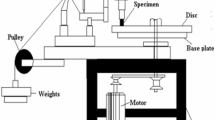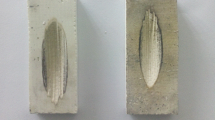Abstract
A study was done to determine the effect of physical, mechanical, thermal and three body abrasive wear response of Silicon Carbide (SiC) filled Glass Fiber Reinforced Epoxy (GFRE) composites. The main purpose was to study the influence of different weight percentages (wt.%) of SiC filler in addition to that of glass fiber. A three body abrasive wear analysis was conducted by varying different factors such as fiber/filler reinforcement, abrasive particle size, normal load, sliding distance and sliding velocity. An attempt was made to find out the dominant factor and the effect of each factor on specific wear rate analysis. Physical and mechanical properties, i.e. density, hardness, tensile strength, flexural strength, inter laminar shear strength and impact strength, were determined for each weight percent of filler reinforcement to determine the behavior of mechanical properties with varying SiC filler loading. Thermo – mechanical properties of the material, i.e. storage modulus, loss modulus and tan delta with temperature were measured using a Dynamic Mechanical Analyzer (DMA). The result shows the increasing / decreasing trend and critical points of each analysis. The trend and major factors responsible for reducing the specific wear rate were determined. Mechanical properties, i.e. hardness and impact strength, increase with the increase in SiC content, whereas tensile strength, flexural strength and inter laminar shear strength decrease. Worn surfaces were studied using scanning electron microscopy (SEM) to give an insight into the wear mechanisms.
Similar content being viewed by others
References
Zhang SW (1998) State of the art of polymer tribology. Tribol Int 31:49
(1992) ASM Handbook, vol 18. ASM International, Materials Park
Wang QH, Xue QJ, Liu WM, Chen J (2000) J Appl Polym Sci 78:609
Suresha B, Chandramohan G (2008) J Mater Process Technol 200(1–3):306
Bijwe J, Logani CM, Tewari CM (1990) Wear 138(1–2):77
Mohan N, Nataraajan S, Kumaresh babu SP (2011) Mater Des 32(3):1704
Cho MH, Bahadur S (2005) Wear 258(5-6):835
Suresha B, Chandramohan G, Kishore Sampathkumaran P, Seetharamu S (2008) Polym Compos 29(9):1020
Agarwal BD, Broutman IJ (1990) Analysis and performance of fiber composites, 2nd edn. Wiley, New York
(1976) Tensile properties of fiber resin composites. American National standard, ASTM D 3039-76
American society for testing and materials (ASTM) (1984) Standard test method for apparent inter-laminar shear strength for parallel fiber composites by short beam method. In: Annual book of ASTM standards. ASTM D 2344-84. ASTM, West Conshohocken, pp 15–17
American society for testing and materials (ASTM) (1997) Standard test methods for determining the pendulum impact resistance of notched specimens of plastic, 1999. In: Annual book of ASTM standards, vol. 08.01. Standard D 256-97. ASTM, West Conshohocken, pp 1–20
Roy R (1990) A primer on the taguchi method. Competitive manufacturing series. New York
Illston JM, Dinwoodie JM, Smith AA (1979) Concrete, timber and metals. Van Nostrand Reinhold, Crystal City
Vuchkov IN, Boyadjieva LN (2001) Quality improvement with design of experiments: a response surface approach. Kluwer Academic Publishers, Dordrecht
Standard test method for void content of reinforced plastics. In: Annual book of ASTM standards. ASTM D 2734. ASTM, West Conshohocken
Raju BR, Suresha B, Swamy RP (2012) ARPN J Eng Appl Sci 7(4):486
Mohamed SS, Mahmoud TS, Eimahallawi IS, Khalifa TA (2009) Eng Res J 121:29
Thwe MM, Liao K (2002) Compos Part A 33:43
Katoh Y, Kotani M, Kohyama A, Montorsi M, Salvo M, Ferraris M (2000) J Nuclear Mater 283–287(2):1262
Chandra Sarath D, Avadhani GS, Kishore Sampathkumaran P (1991) Mater Sci Eng A 136(30):179
Patnaik A, Satapathy A, Biswas S (2010) Malaysian Polym J 5(2):37
Mantry S, Satapathy A, Jha AK, Singh SK, Patnaik A (2011) Int J Plast Technol 15(1):69
Patnaik A, Satapathy A, Mahapatra SS, Dash RR (2009) J Reinforced Plastics Compos 28(11):1305
Ward IM, Sweeney J (2004) An introduction to the mechanical properties of solid polymers. Wiley, USA
Jinmin Z, Perez J, Catherine RR, Earique JL (1994) Mater Sci Eng R13:325
Chen Y-H, Francis JA, Miller JR (2002) Surface temperature of the Arctic: comparison of TOVS satellite retrievals with surface observations. J Climate 15:3698–3708
Kumar S, Satapathy BK, Patnaik A (2011) J Mater Sci 46:7489
Kumar S, Satapathy BK, Patnaik A (2011) Mater Des 32:2260
Author information
Authors and Affiliations
Corresponding author
Rights and permissions
About this article
Cite this article
Agarwal, G., Patnaik, A. & Sharma, R.K. Thermo-Mechanical Properties and Abrasive Wear Behavior of Silicon Carbide Filled Woven Glass Fiber Composites. Silicon 6, 155–168 (2014). https://doi.org/10.1007/s12633-014-9184-4
Received:
Accepted:
Published:
Issue Date:
DOI: https://doi.org/10.1007/s12633-014-9184-4




